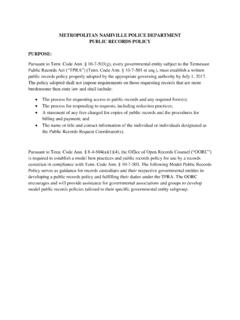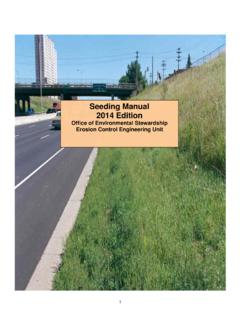Transcription of Stormwater Management Manual 2020
1 Volume 5 Low Impact Development Manual1 Metropolitan Nashville Davidson CountyStormwater Management Manual2020 Table of ContentsChapter to Use This / Low Impact Development?.. Regulatory Management Goals / Urban BioretentionGIP-03 Permeable PavementGIP-04 InfiltrationTrenchesGIP-05 Water Quality SwaleGIP-06 Extended Detention PondGIP-07 grass ChannelGIP-08 Sheet FlowGIP-09 ReforestationGIP-10 CisternGIP-11 Green RoofVolume 5 Low Impact Development Manual2 Metropolitan Nashville Davidson CountyStormwater Management Manual2020 FiguresFigure 1 Site Planning 2 Site Example with Land 3 Series Credit 1. Green Infrastructure 2. Site Cover Runoff 3. Green Infrastructure Practices Runoff Reduction Credit 4. Media Volume-Based 5. Effectiveness of SCMs in Meeting Stormwater Management 6.
2 Green Stormwater Infrastructure Land Use andLand Area Selection Water Services would like to thank the Virginia Department of Conservation and Recreation for allowingreference to their Stormwater Design Specifications andproviding support in the development of this 5 Low Impact Development Manual3 Metropolitan Nashville Davidson CountyStormwater Management Manual2020 Chapter toUseThis ManualThis Volume presents an introduction to Low Impact Development (LID) design and specifically Green InfrastructurePractices (GIPs) which are characterized by their ability to reduce Stormwater runoff volume through the use ofinfiltration, evapotranspiration, and/or rainwater describes how LID designs should be selected, and contains aseries of focused and concise fact sheets for each type of is anaddition tothe Metropolitan Government ofNashville and Davidson County s (Metro s) Stormwater Management Manual (SWMM), which contains the followingvolumes:Volume 1 RegulationsVolume 2 ProceduresVolume 3 TheoryVolume 4 Best Management Practices (BMP)Volume 5 Low Impact Development (LID) DesignPlease see Volume 1 for information about site development, permitting procedures, and post-construction StormwaterControl Measure (SCM) Volume 5 contains the following four chapters.
3 Chapter 1explains how to use thisManual, how it relates to the other volumes 2discusses principles of site layout, currentincentives topromote the use ofLID and an Operationsand Maintenance 3explains the methodology surrounding runoff reduction and how itshallbeapplied,includingdetailed guidance on design sizing and 4contains detailed specifications for planning a site,thisManualmay bebest used in the order shown inFigure1, PlanningProcessSTEP 1 Check incentives (Ch. 2)Site Layout/Planning (Ch. 2)STEP 2 Select GIP (Ch. 4)Check Runoff ReductionPercentages & size GIP (Ch. 3)STEP 3 Implement GIP according toDetailed Specifications (Ch. 4)O&M Guidance (Ch. 3)Volume 5 Low Impact Development Manual4 Metropolitan Nashville Davidson CountyStormwater Management Green / Low ImpactDevelopment?
4 Current development patterns and traditional Stormwater Management techniques have resulted inlarge amounts ofimpervious surfacesin cities across the country approaches tostormwater managementoftenusepractices to quickly and efficiently convey water away from developed largervolumes ofrunoffflowing directly to streams,rivers and combined sewer systemsas well as anypollutants contained in the contrast, LID utilizes a system of source controls and small-scale, decentralized treatment practices to help maintainthe hydrologic function of thelandscapebyallowingwater toinfiltrate,evapotranspirate or be reused onsite. Theconservation of open space, the reduction of impervious surfaces, and the use of small-scale Stormwater controls, suchasgreen roofs, arejust a few of the LID practices that can help maintain predevelopment conditionsand keep greatervolumes ofrunofffromrouting tothe Stormwater InfrastructurePractices(GIP), as used in thisManual,is aterm that refers toa subset of LIDstructural systems and practices that support the principles of LIDand make useof volume-reducing designs and techniques can offer many benefits.
5 Municipalities Protect flora and fauna Balance growth needs withenvironmental protection Installation of GIPs by private sectorparticipationatresidential,commerc ial,andindustrialfacilities Decrease flooding risks for small storms Create attractive natural and multifunctional public spacesDevelopers Reduce landclearing and grading costs Potentially reduce infrastructure costs (streets, curbs, gutters, sidewalks) Reduce storm water Management costs Increase lot and community marketabilityEnvironment Preserve integrity of ecological and biological systems Protect site and regional water quality by reducing sediment, nutrient, andpollutantloads to water bodies Reduce impacts toterrestrial and aquatic plants and animals Preserve trees and natural vegetation Mitigate the heat island effect and reduce energyuseVolume 5 Low Impact Development Manual5 Metropolitan Nashville Davidson CountyStormwater Management of 2016, Metro s National Pollutant Discharge Elimination System (NPDES) Phase I Municipal Separate StormSewer System (MS4) Permit requires that new development and significant redevelopment sites utilizeGIPsfor postdevelopment Stormwater control where possible.
6 The design requirement is to infiltrate, evapotranspire, or capture andreuse the first inch of rain preceded by 72 hours of no measureable rainfall. Metro Water Services (MWS)commissioned this Manual to encourage and incentivize LID design in Metro before its use became a requirement. TheLID Manual was originally released in 2012, with minor revisions adopted in 2013. MWS has used the period since theManual s release to test the methodology while the compliance path was in its judgment strictapplication in a particular situation would conflict with sound engineering practice, Metro Water Services reserves theright to make exceptions to these Management GoalsGIPs are a set of land use and structural practices designed to reduce the volume of Stormwater runoff fromdevelopment through the use of the Runoff Reduction Method (RRM) employing runoff volume reducing overall goal ofGIPsis to reduce Stormwater runoffvolumeand to treat pollutant loadsclose to the sourcewherethey are generated.
7 In doing so,GIPs provide many Stormwater managementbenefits;such as improved water quality,flow Management , groundwater recharge,andchannel minimize the hydrological impacts of urbandevelopment on the surrounding environment by intrinsically linking Stormwater Management to urban design andlandscape architecture. This is accomplished with appropriate site planning andthrough thedirection ofstormwatertowards small-scale systems dispersed throughout the site. These systems should becarefully selected based on the site stopographic and climatic have numerous benefits and advantages over conventional Stormwater Management . The following benefits canbe achieved by applyingGIPs to new development, redevelopment, and capital improvement projects: Provide volume control and pollutant removalUnder traditionalflood-focusedstormwater Management , the importance of volume control from smaller stormsand from the first flush of larger storms is overlooked.
8 Reducing the amount of Stormwater runoff, however, is oneof the most effective Stormwater pollution runoff volume and decrease theamount of stormwaterdirectlyentering streams andsewer systems. In addition to reducing runoff volumes,individualGIPscan help address specific pollutant removal efficiencies through settling, filtration, adsorption, andbiological uptake. By doing so,GIPscan help improve the receiving water s aquatic and terrestrial wildlife habitatand enhance recreational uses. Recharge groundwater and stream base flowsDevelopment tends to increase imperviousness, leading to increaseddirectrunoff and reduced rainfall feed lakes and streams, and significant reductionsor loss of groundwater recharge can reducebase flow in receiving waters, negatively impacting biological habitat and recreational runoff, thuspromotingground water recharge.
9 Restore and protect stream channelsChannel erosion,on average,is estimated to account formostofthesediment load in urban watersheds and is asignificant contributor toTotal Suspended Solids (TSS)issues inmiddle help protect orreduce stream channel degradation from accelerated erosion and sedimentation during and immediately after stormevents by capturing Stormwater volumeand lowering stormwaterpeaks. By protecting stream channels, stream andriparian ecosystems have the potential to beimproved 5 Low Impact Development Manual6 Metropolitan Nashville Davidson CountyStormwater Management Manual2020 Address Combined Sewer OverflowsGIPscan be used to reduce stormwaterinflows to combined sewer systems (CSS) that lead miles in theCSSarea. Details of using green infrastructure in theCSSarea are featuredinMetro s Green Infrastructure Master Plan(MWS, 2009).
10 Provide ancillary environmental benefitsGIPsprovide additional benefits, such as improved aesthetics through the use of attractive landscaping features(trees, shrubs, and flowering plants) which can increase property benefits include increasedpublicawarenessofstormwater Management and water quality issuessince practices are dispersed throughoutasite andaretypically more such as green roofs,bioretention, and urban treescanhelp tomitigate theurbanheat island effectand green roofs canalsodecrease the energy required to heat and cool 5 Low Impact Development Manual7 Metropolitan Nashville Davidson CountyStormwater Management Manual2020 Chapter 2 PLANNING, DESIGN, INCENTIVES, AND OPERATIONS AND Goals / PrinciplesCorrectly pairing land uses with GIPs is an important first step in site be matched with land useandsettingbased on the criteria found in Chapter 4.




